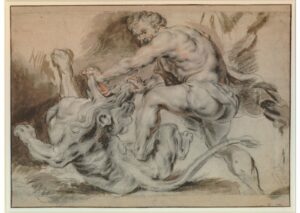

I went to the British Museum recently and discovered a room I have been meaning to visit for a while to verify that it actually exists! And it does – hidden in the back of the Prints and Drawing room (room 90) is an archive of drawings, prints and etchings which you are not only able to see but to handle and sketch for free! It is a little gem and a fantastic resource to study anything from the British Museum collection.
I went through a box of Goya’s Disaster’s of War etchings depicting the cruelty of war between Spain and France. Their fantastic graphicness brutally captures horrific acts of violence and details the despair in the victims faces. Tonal values are used with aquatint to create space and depth. Ni por esas (Neither do these) shows soldiers dragging women away into the darkness. I admired the contorted figure of the women interlinking with the arms of the soldier which dominate the picture and exemplify the inhumanity.

In many of the etchings Goya has the bodies of the murdered crumpled up in indistinguishable piles on the floor. These jagged, cubic forms are very different from the free flowing, exuberant beings drawn by Rubens. The two sketches I saw by Rubens had figures full of life in the midst of a great struggle. The first drawing done in red chalk had multiple compositions of two men wrestling and one larger composition to the bottom right of a man wrestling a lion. Their flowing forms seem to merge into an orgy of writhing bodies battling each other. The wispy lines create a great sense of movement and balance in the figures which lead to the dramatic struggle in an exaggerated theatrical moment, reminiscent of a Judo match.

The second more finished drawing depicts a more worked out figure wrestling a lion as seen in the first drawing. It is Samson fighting a lion by forcing the lion’s jaw apart with both hands and with his left foot crushing down on the lion’s back. It contains the same exuberance as the first drawing but the free flowing drawing is used to model the muscular back of Samson and curly main of the lion. The muscularity is further defined by highlights and shading in a bluey/ grey. It reminded me of the monumentality of figures painted by William Blake. Like The Ghost of a Flea the figures are both set on a stage and have a crazed look on their faces. Obsessive and sinister descriptions of power.



Leave a Reply